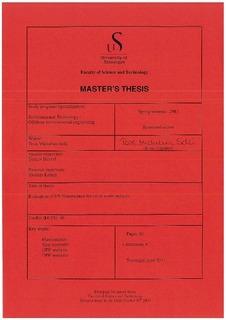| dc.contributor.author | Solli, Tove Michelsen | |
| dc.date.accessioned | 2014-02-06T08:54:56Z | |
| dc.date.available | 2014-02-06T08:54:56Z | |
| dc.date.issued | 2011-06 | |
| dc.identifier.citation | | no_NO |
| dc.identifier.uri | http://hdl.handle.net/11250/182582 | |
| dc.description | Master's thesis in Offshore environmental engineering | en_US |
| dc.description.abstract | Slop water is a mixture of various fluids that is generated during drilling and well operations offshore and it can also be water from operations such as pit and rig cleaning and rainwater from drilling area or areas on the rig adjacent to drilling area. Due to government regulations and environmental concerns the slop water must be treated before it can be discharged. According to the activities regulations Chapter XI, § 60 Discharge of oily water; “the requirement is that the oil content shall not exceed 30 mg oil per liter of water as a weighted average for one calendar month”.
Treatment of slop water has mostly been done by transporting it to an onshore treatment facility. Halliburton has newly launched a mobile offshore treatment plant for slop water were the basic principle is chemical flocculation with dissolved air flotation (DAF).
In Chapter XI, of the activities regulations § 70 Measuring the discharged quantity of oil, other substances and water it states that; “the content of oil and other substances in the discharges shall be measured”. “The test results shall be used to verify the treatment plant's performance.” To verify that the discharge of oily water is according to § 60 Halliburton uses an instrument called OIW EX 1000. This analyzer is based on molecular fluorescence spectroscopy. The oil content is then determined by applying UV radiation at a specific wavelength to a sample and measuring the amount of energy that is emitted by the oil. The instrument has normally been used for produced water and Halliburton is the first company to use the instrument to analyze treated slop water. Produced water contains crude oil that has a high content of aromatics and according to theory aromatics has the most intense fluorescence. Slop water on the other hand have don’t contain aromatics, the oil based mud are normally mineral oils or linear paraffin. These oil types have aliphatic carbonyl structures and according to theory only a small number of these compounds may exhibit fluorescence.
In this thesis different test were performed to evaluate if this instrument is a valid method to measure oil in treated slop water and find out which operating parameters can influence the measurements and whether or not they can be neglected.
After evaluating all the data it was concluded that the advanced sensors EX OIW 1000 is a valid method for measuring oil content in slop water but only if it is calibrated and adjusted correctly. The instrument should be adjusted so the spectra of the base oils are read at 510 nm to achieve the best measurements, and a mask should be applied to the spectra to eliminate any uncertainties in the intensity. Two parameters can have a profound effect on the measurements; droplet oil size and concentration. A procedure was developed to verify the instrument according to ISO 9377-2. | en_US |
| dc.language.iso | eng | no_NO |
| dc.publisher | University of Stavanger, Norway | no_NO |
| dc.relation.ispartofseries | Masteroppgave/UIS-TN-IMN/2011; | |
| dc.subject | fluorescence | en_US |
| dc.title | Evaluation of UV fluorescence for oil in water analysis | no_NO |
| dc.type | Master thesis | no_NO |
